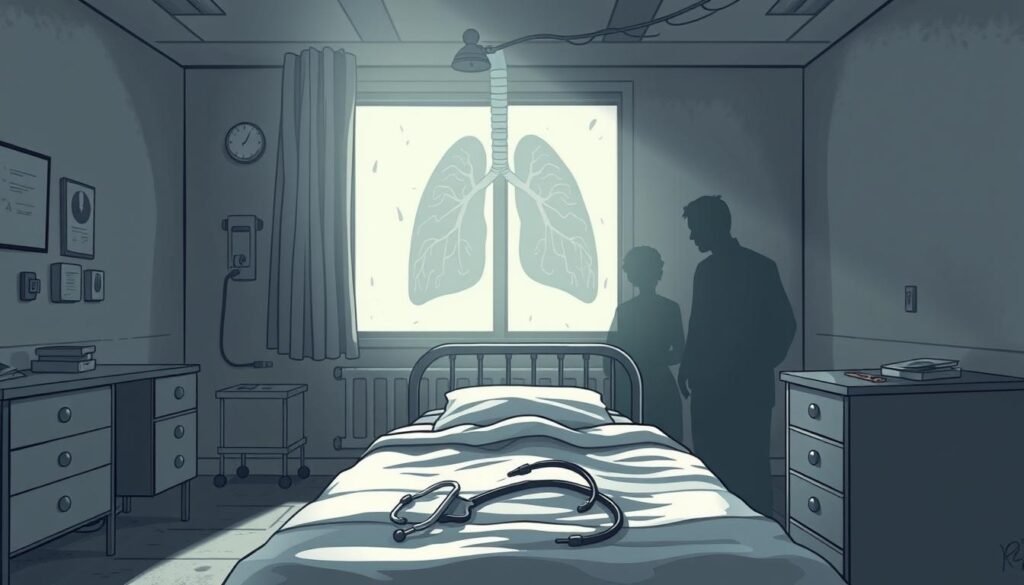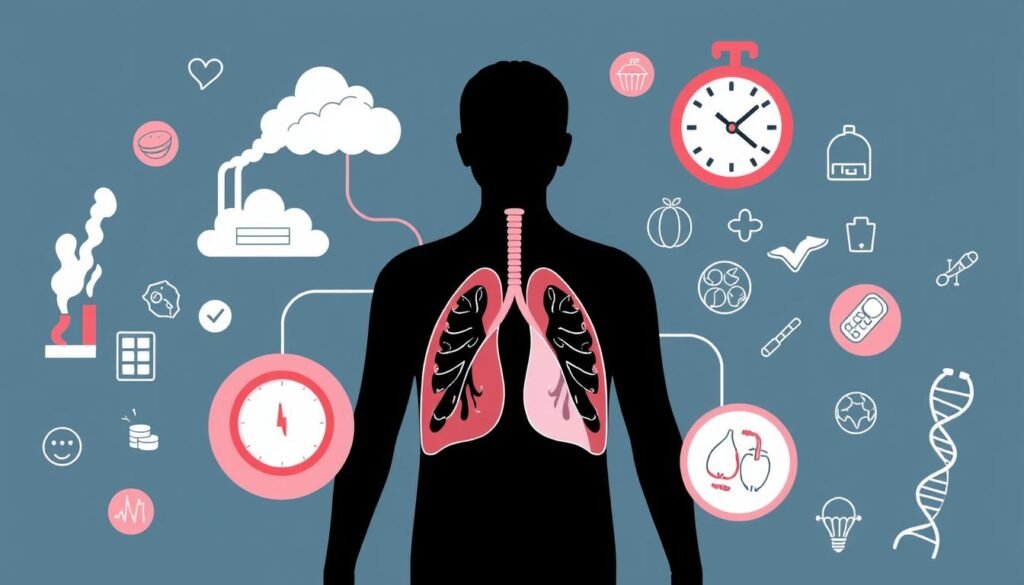If untreated, non-small cell lung cancer (NSCLC) patients usually live for only 5 to 12 months. This fact shows how critical treatment is when dealing with lung cancer. Choosing not to get treated greatly affects how long someone with lung cancer might live. This choice is often based on personal reasons. These might include worries about quality of life or money issues.
It’s key to know how untreated lung cancer affects life expectancy. Survival rates change a lot depending on the type and stage of the cancer. For example, people with small cell lung cancer (SCLC) typically live 3 to 15 months without treatment. Knowing about treatment options is very important. This article will explore the impact of not treating lung cancer on how long patients might live.
Key Takeaways
- Untreated NSCLC patients usually survive for 5-12 months.
- Untreated SCLC typically allows survival of 3-15 months.
- Quality of life and financial concerns often influence treatment decisions.
- Understanding lung cancer stages is vital for prognosis.
- Survival rates differ significantly between NSCLC and SCLC.
Understanding Lung Cancer
Lung cancer is a major health issue for many. To understand it, we start with the basic lung cancer definition. It occurs in the lungs from the rapid growth of abnormal cells. Knowing about these cancerous changes helps identify different lung cancer types.
There are two main kinds: non-small cell lung cancer (NSCLC) and small cell lung cancer (SCLC). Each type has its own attributes and treatments. NSCLC makes up about 85% of all cases. Meanwhile, SCLC is rarer but spreads faster, often leading to a tougher fight.
Learning the lung cancer basics is key for those affected. Catching it early and starting treatment improves chances and life span. Survival rates also depend on the disease stage when found and overall health. Knowing these facts helps people choose the best care for them.
Types of Lung Cancer
Lung cancer is mainly split into two types: non-small cell lung cancer (NSCLC) and small cell lung cancer (SCLC). These types show different growth rates, treatments, and outcomes.
Non-Small Cell Lung Cancer (NSCLC)
NSCLC makes up about 85% of lung cancer cases. It is the most common type. This cancer grows slower than SCLC. This slowness increases chances for finding it early and treating it effectively.
The five-year survival rate for early-detected NSCLC is around 63%. But, it falls to about 7% for advanced cancer. Knowing the stages of NSCLC is key for choosing the best treatment. For a deep dive into lung cancer stages, see this guide: lung cancer stages.
Small Cell Lung Cancer (SCLC)
SCLC represents 10-15% of lung cancer cases. It’s very aggressive. This cancer quickly grows and spreads, leading to worse outcomes.
Without treatment, life expectancy for late-stage SCLC is roughly 6 to 12 months. The five-year survival rates for SCLC are low. Early-stage cases have a survival rate of about 29%, while advanced stages fall to 3%. It’s important to understand these lung cancer types for treatment decisions.
Lung Cancer Stages and Their Impact
Lung cancer stages are key in deciding treatment and predicting outcomes. Each stage shows how much the disease has spread. This helps in making medical choices and setting expectations for patients.
Stage I
Stage I is when the cancer hasn’t moved past the lung. This stage has the best survival rates. Many patients live at least five years after being diagnosed.
The high survival chance highlights why catching the disease early is vital. Early detection and action can save lives.
Stage II
In Stage II, the cancer might reach nearby lymph nodes but is still mainly in one place. Survival rates drop to about 35%. This shows that treatment gets harder.
Doctors may need to use stronger treatments to fight the cancer. Stage II requires a tough approach to care.
Stage III
At Stage III, the cancer has spread to lymph nodes in the chest. Only about 15% of patients survive this stage. This shows how serious the disease has become.
Treatment now may involve chemo, radiation, and surgery. Each plan is tailored to what the patient needs.
Stage IV
Stage IV is the most advanced, with cancer moving to distant organs. Here, the survival rate falls to 5%. It’s crucial to seek immediate medical help.
Treatments like immunotherapy and clinical trials may be options. This stage shows how critical proper cancer staging is for treatment and care.
How Untreated Lung Cancer Affects Life Expectancy
Not treating lung cancer greatly reduces how long someone can live. Without any therapy, people with non-small cell lung cancer (NSCLC) usually only last around 7 months. Those with small cell lung cancer (SCLC) might have even less time, living just 2 to 4 months.
The stage of lung cancer at diagnosis is key to what one can expect. Persons found to have it late often don’t live long without treatment. Data shows around 25-30% of people with advanced NSCLC survive less than 3 months. This makes finding and treating lung cancer early very important for living longer.
The national stats show a grim picture with only an 18.6% 5-year survival rate for lung cancer. This low number shows how vital treatment is to improve survival chances. Also, lung cancer is the top cause of cancer deaths, making up about 25% of all such deaths in the U.S.

Ignoring lung cancer treatment affects not just the patient but also the healthcare system. Getting treatment on time can change a patient’s outcome and life quality dramatically. It’s very important to understand the serious effects of not treating lung cancer to raise awareness and encourage early action.
Life Expectancy Statistics for Untreated Lung Cancer
Lung cancer’s survival depends heavily on its type and stage, especially without treatment. Knowing these stats shows the hard truth of untreated lung cancer. Patients with non-small cell lung cancer (NSCLC) have a median survival time of about 7.15 months without treatment. On the other hand, those with small cell lung cancer (SCLC) have a much lower survival range, from 2 to 4 months.
Non-Small Cell Lung Cancer Survival Rates
For untreated NSCLC, survival varies greatly with the disease’s progression. Research shows that many patients could live longer than the average survival time if they get medical help early. These facts clearly show the need for early diagnosis and treatment among different groups.
Small Cell Lung Cancer Survival Rates
SCLC survival rates are much lower than NSCLC. This is due to SCLC’s fast growth, leading to late-stage diagnosis where patients may have only a few months left. Recognizing the importance of early treatment can improve a patient’s lifespan and quality of life. Thus, starting treatment right after diagnosis is crucial.
| Cancer Type | Median Survival Time (Untreated) | 5-Year Survival Rate |
|---|---|---|
| Non-Small Cell Lung Cancer (NSCLC) | 7.15 months | 28% (overall) |
| Small Cell Lung Cancer (SCLC) | 2-4 months | 7% (overall) |
These facts highlight the urgency for those diagnosed with lung cancer to consider treatment options and regular screenings. Doing so could greatly improve NSCLC survival rates and SCLC survival rates. You can find more info on how to boost survival rates here.
Factors Influencing Lung Cancer Survival Rates
Many factors are key in figuring out lung cancer survival rates. Understanding these helps in making clearer plans for treatment and care. They include the cancer’s stage, the patient’s age, their overall health, and their ability to carry out daily tasks.
Each factor affects how treatments are designed and patient outcomes.
Cancer Stage and Grade
The stage of cancer when it’s found greatly impacts survival. Early-stage lung cancer has a higher chance of a good outcome. For example, early stages of non-small cell lung cancer have much better survival rates than later stages.
A recent review showed that patients found at advanced stages have a lower chance of living as long.
Age and Overall Health
How old a patient is greatly affects their lung cancer outcome. Older people, especially those over 60, often don’t do as well. Also, being in good health can mean more treatment options are available.
But, people with other health problems might not have as good a chance at a positive outcome.
Performance Status
A patient’s ability to do everyday activities is a big factor. It tells doctors how well a patient might handle treatment and their chances of survival. Those with better scores tend to do better.
For instance, patients with scores over 2 often have a lower survival rate. Paying attention to this can help manage lung cancer better.

| Factor | Description | Impact on Survival |
|---|---|---|
| Cancer Stage | The extent of cancer spread at diagnosis. | Earlier stages correlate with higher survival rates. |
| Age | Age of the patient at the time of diagnosis. | Older patients have reduced survival chances. |
| Overall Health | General health status and any pre-existing conditions. | Better health enables more treatment options and improved outcomes. |
| Performance Status | Patient’s capability to perform daily activities. | Higher performance status indicates better prognosis. |
Consequences of Untreated Lung Cancer
Untreated lung cancer goes beyond harming physical health. It causes chronic cough, trouble breathing, and chest pain. These symptoms greatly reduce a person’s quality of life.
Fatigue is a major issue for those with advanced lung cancer. The struggle to function wears on the body, leading to worse well-being. In extreme cases, untreated lung cancer may lead to pneumonia or lung collapse. These problems make lung cancer symptoms even worse.
The effects of untreated lung cancer aren’t just physical. They include psychological strains too. People often face anxiety and depression from their diagnosis and uncertainty. Emotional support is crucial for dealing with these impacts. It shows how important mental health resources are for those fighting lung cancer.
Untreated lung cancer also harms personal and work lives. Relatives and close friends frequently take on caregiving roles, adding emotional stress. Likewise, job performance can drop as patients find daily tasks harder to handle.
Palliative Care for Lung Cancer
Palliative care is crucial for those facing lung cancer, especially if they don’t choose curative treatments. It focuses on easing symptoms, boosting lung cancer quality of life, and giving full support. It’s more than just managing symptoms; it includes emotional and psychological help to keep dignity and comfort.
Many lung cancer patients realize too late that their disease has progressed. About 80% of lung cancers are found after spreading. For these patients, the outlook can be grim, with just 10% living more than five years after being diagnosed. End-of-life care aims to make patients comfortable and reduce distressing symptoms.
Care can happen in many places, like the patient’s home where family often helps. Caregivers get breaks through respite care, ensuring the patient is still looked after. After losing someone, families get bereavement care, which is important and can last a year.
Costs for hospice care are often covered by Medicare, veterans’ benefits, and Medicaid, with private insurance coverage varying. Even though 61% of cancer patients use hospice services, most only receive it for about 9.1 days before passing away. This highlights the importance of discussing palliative care options early with healthcare providers.
Starting palliative care early can make a big difference. Patients with advanced lung cancer who received it when diagnosed had a better quality of life. They also had fewer signs of depression than those who got standard cancer care. Those who got early palliative care lived about 11.6 months, versus 8.9 months for others.
| Care Type | Duration | Coverage |
|---|---|---|
| Hospice Care | Average of 9.1 days | Medicare, Tricare, Medicaid, private insurance |
| Respite Care | Up to 5 days | Varies by state and policy |
| Bereavement Care | Up to 1 year | Typically covered by hospice |
Understanding palliative care is key for lung cancer patients looking for improved life quality and support. Choosing these options, especially with an advanced diagnosis, can deeply affect the well-being of patients and their families.

Quality of Life with Lung Cancer
Lung cancer affects a person’s life deeply. Those with lung cancer deal with tough symptoms like fatigue and coughing. These issues can make everyday tasks hard and lower happiness. Depression and anxiety often occur too, making things even harder.
Lung cancer patients face difficult symptoms. Fatigue and losing appetite are most common, at 98%. They also struggle with breathing issues (94%) and pain (90%). These problems make life challenging. Knowing about different treatments is key for managing these symptoms well.
New treatments are bringing hope to lung cancer patients. Targeted therapies and immunotherapy are among these. It’s important for patients to understand their treatment options. This understanding can boost survival rates and improve their quality of life. For latest updates on treatments, check out this resource.
| Aspect | Details |
|---|---|
| Main Symptoms | Fatigue (98%), Loss of Appetite (98%), Respiratory Problems (94%), Pain (90%) |
| Survival Rates | Stage 1: ~65%, Stage 2: ~40%, Stage 3: ~15%, Stage 4: ~5% |
| Average Life Expectancy | NSCLC: 11-13 months, SCLC: 7-16 months |
| Impact of Treatment | Patients receiving surgery can expect an average of 76.7 months of life. |
Knowing about lung cancer helps patients and families strive for the best quality of life. Support from doctors, treatment access, and managing symptoms are vital. They greatly improve living with lung cancer.
Conclusion
Lung cancer is a serious issue, especially without treatment. It lowers survival rates and hurts quality of life. The world saw over 18.1 million new cases in 2020. Knowing how important treatment is matters for those affected. The survival rates for advanced lung cancer are quite low, at only 9% over five years. This shows why it’s vital to seek medical help early.
When diagnosed with lung cancer, patients need to consider their options carefully. They can look into chemotherapy, immunotherapy, and care that eases symptoms. These can help even in late stages. Experts like Dr. Suresh Ramalingam and Dr. Alice Shaw offer new treatments. These can improve how long and how well people live. You can find more about these experts here.
Making wise choices after learning about lung cancer is key. Talking openly about treatments and managing symptoms with doctors is crucial. This helps maintain respect, comfort, and health. Finding and treating cancer early boosts survival chances. It also makes life better for those facing this tough challenge.